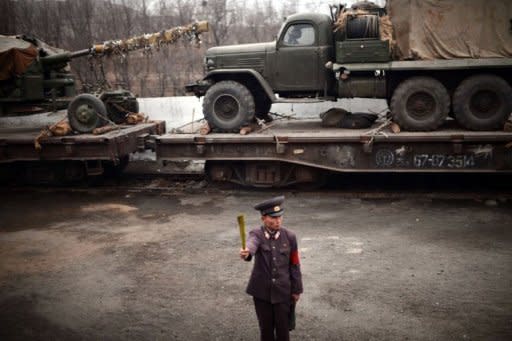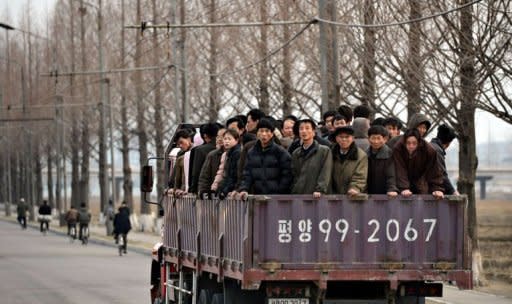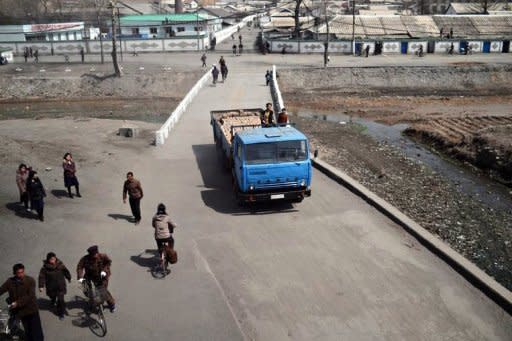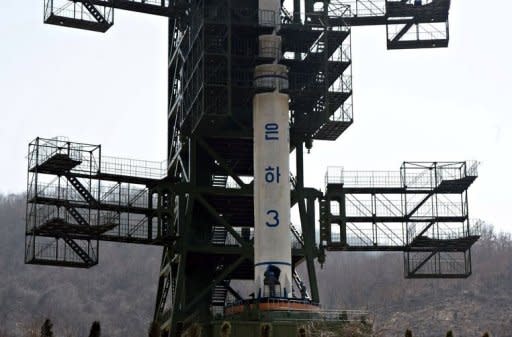Rice paddies and rocketry: a journey through N. Korea
North Korea is hardly known for offering a warm welcome to the world's press, and never before has it given access to a sensitive site featuring its latest space hardware. However, insistent that its upcoming rocket launch poses no offensive threat, the communist state invited some 50 reporters, cameramen and photographers on Sunday to view the brand-new launch site in its far northwest. The journey by train from the showpiece capital Pyongyang took the media contingent through the world's most secretive country, a nuclear power where food shortages persist since a 1990s famine killed hundreds of thousands. But North Korea, under the new leadership of Kim Jong-Un, has invited the world media to come in force as it gears up for this weekend's 100th anniversary of the birth of its founding leader, Kim's grandfather Kim Il-Sung. To honour the anniversary, North Korea says, the rocket will place a research satellite called Kwangmyongsong-3 (Shining Star) in orbit sometime between April 12 and 16. The United States, South Korea and others insist that the launch is a ballistic missile test in disguise, in flagrant violation of a UN ban. Japan has deployed anti-missile systems to shoot down the rocket if necessary. The journey to the launch site starts at 8:30am with minders shepherding the press contingent from their Pyongyang hotel onto buses with this stern instruction: "From now on, you need our permission to film or take photos." But the hunger for images from North Korea is so ravenous that as soon as the buses begin to move, everyone gets out their equipment and starts shooting. Against all expectation, the minders do not intervene. The buses head past Pyongyang's main train station, watched over by a giant portrait of Kim Il-Sung, and reach what appears to be a private station. The buses pull up directly onto the platform. The young new leader's father Kim Jong-Il, who died in December, had a reported fear of flying and went everywhere in a special train fitted out in high style. This private station could well be the one that Kim used. Equipped with sleeper carriages, the comfortable train awaiting the media certainly seems reserved for the regime's elite, with catering provided by the national airline Air Koryo. It is a far cry from the rickety train that brought two AFP journalists to Pyongyang from Dandong in China. In barely no time, the train has left Pyongyang behind. Fields open up, dotted with villages featuring white-walled houses and pagoda-style roofs with brown-ochre tiles. Tractors are a rare sight in the fields and rice paddies that line the twin-track railway. Most North Koreans still live on the land, and most still farm by hand or with oxen. There are plenty of women and children tilling the fields or washing their rice crops. Most appear suitably dressed against the spring chill, and have footwear on. This part of North Korea, in the northwest, is far more privileged than the northeast, where UN agencies say that malnutrition remains chronic. After about four hours, the train reaches a town called Tongnim, about 50 kilometres (30 miles) from the Chinese border. It leaves the main railway and heads down a single track to the Cholsan peninsula on the Yellow Sea. Rice fields remain the norm alongside the track but here, the tractors are newer and a lot more common. This region serving the Tongchang-ri space centre is, clearly, even better endowed with state resources. The train comes to a halt after another hour. The countryside is now deserted. In the distance between two hills, standing clearly in the brilliant spring sunshine, is the journey's end: the three-stage rocket on its launch platform. The media scrum pushes for the windows to grab a shot. The white rocket stands 30 metres (99 feet) high. On the main booster section, in sky-blue lettering, is written in Korean "Unha 3", or Galaxy 3. Above the lettering is painted the North Korean flag. A small, smiling man welcomes the media. Jang Myong-Jin, the 46-year-old chief of the space centre, holds court for about three hours, answering a battery of questions without losing his composure. Jang is adamant that the launch is entirely peaceful, a proof of North Korean engineering prowess, and that no other country has any right to interfere. So ends a carefully choreographed visit at the start of what promises to be a week of stage-managed events in Pyongyang and beyond, designed to entrench the deeply isolated nation's second dynastic succession.













